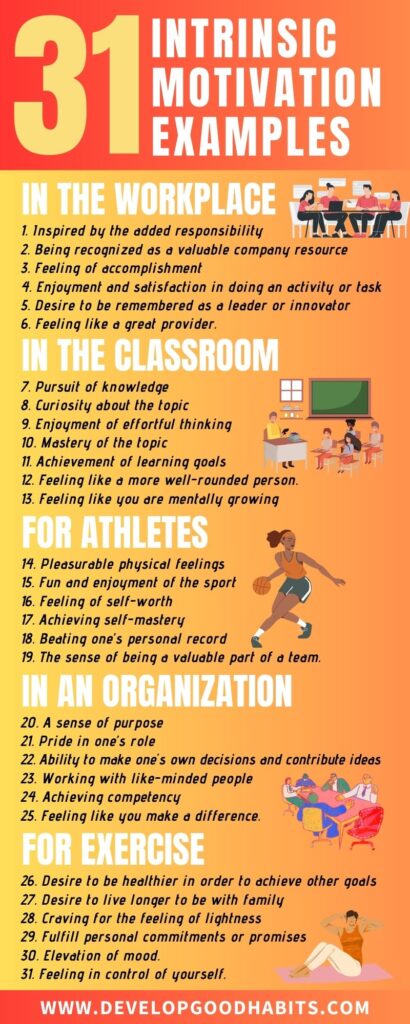There might be affiliate links on this page, which means we get a small commission of anything you buy. As an Amazon Associate we earn from qualifying purchases. Please do your own research before making any online purchase.
It’s Monday morning and your alarm clock is going off. Why do you get out of bed?
- You have to get to work to earn a paycheck
- You get to start a new week of using your expertise and skills to make a difference that matters to you
- 1 and 2
- I don’t work, this example doesn’t apply to me, let me keep reading to find one that does.
No matter what your answer is to this question, it starts with whatever factor motivates you to take that action of getting out of bed.
Your motivation to do anything is a psychological process that relies on some type of incentive for you to take action to obtain your wants and needs.
There are two types of motivation: intrinsic motivation and extrinsic.
While both are important factors in achieving success, experts have found that these two types of motivation have different impacts on human behavior and the actions people choose to move forward in the pursuit of their goals.
To understand how intrinsic and extrinsic motivation influence your actions and behaviors, it’s important to first know the difference between the two and how each works.
In this article, we will look at what intrinsic and extrinsic motivation are and how you can determine if your own sense of motivation (or someone else’s) is an internal feeling or it’s coming from some external factor.
Let’s get to it.
Definitions of Intrinsic vs. Extrinsic Motivation
Intrinsic Motivation
When you’re intrinsically motivated to do something, you feel an internal prompt to engage in the behavior because it is naturally enjoyable or satisfying to you.
This type of motivation happens when you act without having an expectation to gain an external reward after engaging in the behavior. You simply find the activity to be personally satisfying or view it as a chance to learn and realize your potential.
Here is a personal example that you can probably relate to: I feel a huge sense of intrinsic motivation to drive out to visit my best friend at least twice a month. I don’t go to see her expecting anything in return–I’m only expecting to gain an internal sense of happiness and satisfaction from being in her company.
I’m not trying to obtain a certain social status by associating with her or earn money by babysitting her children. I just enjoy her company. (Here are more examples of intrinsic or inner goals.)
When you do something because it brings you enjoyment, personal fulfillment, or a sense of satisfaction, you’re doing so with a sense of intrinsic motivation–so you’re not looking for a reward or acclaim.
However, that isn't to say that doing things because you’re intrinsically motivated to do so comes without its own unique types of rewards. These rewards are just more about producing positive emotions.
For example, volunteering for an organization that is important to you will give you a sense of purpose and progress, especially if you’re able to see the positive results of your work. Learning new things from such experiences is also an intrinsic reward if you’re learning to fulfill your own sense of curiosity.
In this case, along with learning about other cultures or the various needs in your community, volunteering can also help you learn new skills such as teamwork, leadership, communication, and a positive work ethic.
Take a second to think about your motivation for learning right now.
Why are you reading this article?
Are you interested in learning about human behavior and motivation?
Do you find this information to be fascinating and you genuinely want to be informed?
If so, you’re acting on a sense of intrinsic motivation. Alternatively, if you have to gather articles on this topic in order to get a decent grade on a paper, you’re acting on a sense of extrinsic motivation.
Let’s look more at what extrinsic motivation entails.
Extrinsic Motivation
Extrinsic motivation is what influences the behaviors that you engage in with the expectation of receiving some type of external reward in the end, such as money, acknowledgement, or good grades.
This kind of motivation comes from outside sources, as opposed to intrinsic motivation, which stems from inside of the individual.
When you’re extrinsically motivated, you’ll continue to engage in a behavior, even if it’s not rewarding in and of itself.
For example, someone who works as a line cook probably performs routine tasks that aren’t very enjoyable. However, because they’re expecting a paycheck for doing these tasks, they still feel a sense of motivation to complete them.
Here is another personal example that is highly relatable: I spend many, many hours each week running. Do I enjoy it? Honestly…not really. Yes, I know some people do enjoy exercising in the morning, and that’s great. But me?
I would rather stay in bed for another 1.5 hours. However, I’ll admit it, I want to stay physically fit and maintain my appearance. To me, that reward makes putting forth the extra effort each morning to go for a run worth it.
Maintaining your fitness is an example of an extrinsic reward that isn’t as tangible as something like a paycheck–and some extrinsic rewards are even more psychological.
When thinking of a tangible reward, of course money and recognition are quick to come to mind, as people often do things that they would rather not do (if given a choice) in order to earn these things.
Of course not everyone loves their job… but they still show up to work each day. Speaking of which, if you're interviewing for a job and the “What motivates you?” question pops up, here's how to answer.
When it comes to receiving recognition as a tangible reward, athletes endure tough training sessions to be able to compete in their sport to win–and I’m sure there are many instances in which they would rather be lounging on the beach than exerting all of that physical effort.
Some psychological forms of extrinsic motivation may include a type of stamp of approval from other people or social admiration. A person may go the extra mile at work to earn praise or attention from their boss. Or a child may clean their room in an attempt to get a pat on the back from his or her parents.
In both of these examples, the reward is neither physical nor tangible, but it’s still a source of motivation that comes from an external source.
Extrinsic motivation probably impacts you on a daily basis more than you realize.
Aside from having a job (if you are employed), think about any loyalty cards that you shop with at stores to acquire points or receive special discounts. Or perhaps you use a specific credit card to get hotel points or airline miles.
Here are some other everyday examples of extrinsic motivation:
If you want to learn more, read this post about extrinsic motivation examples.
Now that you know the difference between intrinsic and extrinsic motivation, let’s take a look at how you can use this information to improve your life and influence those around you.
How to Determine the Source of Motivation
A distinction between intrinsic and extrinsic motivation emerged in the 1970s after experimental studies suggested that gaining tangible rewards can actually compromise one’s intrinsic motivation to engage in a behavior.
This means that people tend to lose interest in activities that they once enjoyed after starting to receive a tangible benefit for performing the activity.
Consider this: Have you ever known someone who was able to turn their passion into a career, only to find that their original love for the work ending up fading over time?
What was once an activity that they chose to do on their own time and their own terms became a mandated activity where their sense of autonomy was lost.
If you were a fan of the show Friends, you’ll remember this clip from the episode where Monica had made candy for her neighbors just to do something nice for others living in the building.
However, this nice gesture quickly turned into a tedious task once people were demanding the candy and pressure was put on her to make it as fast as possible.
This is a great example of a behavior that initially came with the benefits of feeling intrinsically rewarded, but was soon overshadowed by gaining the extrinsic “reward” of being liked by her neighbors.
This is not to say that extrinsic motivation is bad–it simply has its limits. And studies have backed this up by demonstrating how intrinsically motivating factors are much more influential than something that can be seen as a bribe of some sort.
This suggests that if you’re in a leadership position, it is important to recognize that intrinsic factors may play a stronger role in motivating your employees than offering the potential for a financial bonus.

This is especially true if you’re trying to build a professional culture that’s based on respect, acknowledgement, trust, and autonomy.
Oftentimes, creating an environment where employees have opportunities to further their professional development and advance their career in some way is the best method of ensuring employees don’t settle on doing mediocre work and stay motivated to put forth their best effort.
Intrinsic sources of motivation can also have a stronger impact on your personal life than extrinsic factors.
When you consider the things that are most important to you in life, does your mind go to your tangible possessions? Or do you think more about memories that you have with family and friends?
Money and possessions are fleeting, and their value will not always remain the same.
So while having the potential to get a bonus at work may be very effective in pushing you to work extra hard in the short-term, this source of motivation will not last forever–as extrinsically motivating factors are rarely sustainable.
Using Motivation to Boost Your Success
A critical component to being successful is being able to know how to effectively motivate yourself.
Rather than relying on a genius idea, luck, or your brilliance alone to become successful, you have to know what gives you that necessary push to not only begin tasks, but also ensure they’re thoroughly completed.
If external sources of motivation–such as money and fame–aren’t as important to you as feeling intrinsically rewarded by your actions, you can remain permanently motivated.
When you’re relying solely on extrinsic value to ensure your (or other people’s) consistent productivity, you’re failing to ignite any sense of passion. All you’re guaranteeing is that the bare minimum amount of work that is required to succeed will get finished, simply in order for the reward to appear.
So, if you’re offering an extrinsically motivating factor to others in an attempt to influence them to do something, you have to make sure that the reward you’re offering will continue to increase in value.
Otherwise, people won’t feel a need to increase their productivity. This is why companies offer raises to their employees–they want their employees to have a good reason to work harder than the status quo.
But what do you do if you feel no motivation at all?
Fortunately, when you feel like you can't get motivated, there are a few small changes you make that will help you regain inspiration and a sense of purpose. Watch the video below 13 habits you can use to get out of a rut if you're experiencing a lack of motivation.
Final Thoughts on the Difference Between Intrinsic and Extrinsic Motivation
Sources of extrinsic motivation make us feel good in the short term, especially if we receive them unexpectedly.
You can use extrinsic sources of motivation to influence others to be successful by saying words of encouragement, offering money, giving them positive attention or personal recognition, etc. if you’re in a leadership position.
However, extrinsic motivation can only influence other people (and yourself) to increase your productivity if you perceive the reward as being more valuable than the effort you have to exert to obtain it.
If your passion for the compensation dwindles, so will your effort toward the related work. Because of this, if you are aiming to provide such a reward to others, you have to be willing to adjust the reward accordingly in order to continue to motivate the people who find the reward to be of value.
In order to keep employees motivated if you’re in a leadership position, make sure you're giving your team the necessary time and resources to develop the skills and explore projects they're independently excited about without making them do these things as a part of their regular job duties, as this could end up backfiring.
Does your team need some extra motivation? Inspire them with these quotes from John Wooden, a National Basketball Hall of Fame inductee and recognized as one the greatest basketball coaches in history.
When it comes to your own work, focus your efforts on the rewards that you want, but don't exhaust yourself by chasing after extrinsic rewards.
Instead, make sure that you're allowing yourself time (both personally and professionally) to do things that you genuinely enjoy just for the sake of doing them to make sure you’re living with a healthy balance of doing things because you want to and doing things because you have to.
Now, if you're looking for more resources about motivation, be sure to check out these articles:
- Intrinsic VS Extrinsic Goals: Which is Better for Your Success?
- Motivation VS Discipline: 7 Differences & Why Discipline is Better
- 9 Ways to Motivate the Other People Around You
Finally, if you want to take your goal-setting efforts to the next level, check out this FREE printable worksheet and a step-by-step process that will help you set effective SMART goals.

Connie Stemmle is a professional editor, freelance writer and ghostwriter. She holds a BS in Marketing and a Master’s Degree in Social Work. When she is not writing, Connie is either spending time with her 4-year-old daughter, running, or making efforts in her community to promote social justice.



